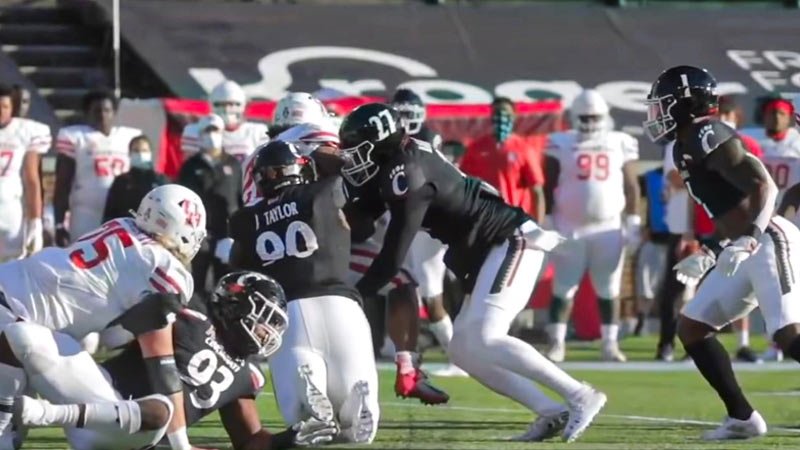The College Football Playoff (CFP) is the system that determines the national champion of the NCAA Division I FBS, the highest level of college football competition in the United States.
It involves four teams that play in two semifinal games and a final game at the end of each season. The CFP was established in 2014, replacing the Bowl Championship Series (BCS) that had been used since 1998.
The CFP aims to create a more fair and transparent way of selecting and ranking the best teams in the country based on their performance on the field and not on polls or computer rankings.
In this essay, I will explain how are teams selected for the college football playoff.
How Are Teams Selected For The College Football Playoff?
The College Football Playoff (CFP) is a system that determines the national champion of the NCAA Division I Football Bowl Subdivision (FBS).
It involves four teams that are selected and ranked by a 13-member committee, which also creates a weekly Top 25 poll starting in the middle of each season.
Here are some points about how the teams are selected for the CFP:
- The CFP Selection Committee consists of current athletic directors, former coaches and players, former administrators, and media members. They are appointed by the CFP Management Committee for three-year terms. The current members are listed here.
- The Selection Committee meets weekly to produce rankings based on their evaluation of the teams’ performance on the field, using various criteria such as conference championships won, strength of schedule, head-to-head results, and comparison of results against common opponents. They also have access to various statistics and data provided by SportSource Analytics2.
- The Selection Committee ranks the teams in groups of six or eight, starting with a pool of 30 teams that each member submits. They then vote on the best teams in each group until they reach the final Top 25. The voting process is explained in detail here.
- The Selection Committee’s final rankings are announced on Selection Day, which is usually the first Sunday of December after all the conference championship games are played.
The top four teams are selected for the CFP semifinals, which rotate among six bowl games: Cotton, Fiesta, Orange, Peach, Rose, and Sugar. The semifinals are played around the New Year’s holiday, and the winners advance to the CFP National Championship Game, which is played at least a week later at a neutral site.
The Selection Committee also assigns teams to the other New Year’s Six bowl games that are not hosting the semifinals based on conference tie-ins and other factors.
The remaining bowl games are determined by contractual agreements between conferences and bowls.
Who Is On The CFP Selection Committee?

The CFP selection committee is a group of 13 people who are responsible for selecting and ranking the four teams that compete in the College Football Playoff, as well as the other teams that participate in the New Year’s Six Bowl games. Here are some points about who is on the CFP selection committee:
- The CFP selection committee consists of current athletic directors, former coaches and players, former administrators, and media members.
They are appointed by the CFP Management Committee for three-year terms. The current members are:
- Gary Barta, University of Iowa athletic director (chair)
- Mitch Barnhart, University of Kentucky athletic director
- Paola Boivin, Arizona State University professor and former sportswriter
- Tom Burman, University of Wyoming athletic director
- Rick George, University of Colorado athletic director
- Joe Castiglione, University of Oklahoma athletic director
- Ronnie Lott, former USC and NFL player
- R.C. Slocum, former Texas A&M head coach
- Ray Odierno, former Army chief of staff
- Todd Stansbury, Georgia Tech athletic director
- Scott Stricklin, University of Florida athletic director
- John Urschel, former Penn State and NFL player and mathematician
- Rod West, Entergy Corporation executive and former Notre Dame player.
- The CFP selection committee meets weekly to produce rankings based on their evaluation of the teams’ performance on the field, using various criteria such as conference championships won, strength of schedule, head-to-head results, and comparison of results against common opponents. They also have access to various statistics and data provided by SportSource Analytics.
- The CFP selection committee ranks the teams in groups of six or eight, starting with a pool of 30 teams that each member submits. They then vote on the best teams in each group until they reach the final Top 25. The voting process is explained in detail here.
- The CFP selection committee’s final rankings are announced on Selection Day, which is usually the first Sunday of December after all the conference championship games are played.
The top four teams are selected for the CFP semifinals, which rotate among six bowl games: Cotton, Fiesta, Orange, Peach, Rose, and Sugar.
The semifinals are played around the New Year’s holiday, and the winners advance to the CFP National Championship Game, which is played at least a week later at a neutral site.
- The CFP selection committee also assigns teams to the other New Year’s Six bowl games that are not hosting the semifinals based on conference tie-ins and other factors. The remaining bowl games are determined by contractual agreements between conferences and bowls.
What Is The Selection Process For The CFP?

The selection process for the College Football Playoff (CFP) is a meticulous and comprehensive procedure that involves several steps, culminating in the selection of the four teams that will compete for the national championship.
Here is a description of the key points in the CFP selection process:
Selection Committee
The CFP selection committee is a group of 13 individuals comprising conference commissioners, athletic directors, former coaches, and other respected figures in college football.
They are selected to serve on the committee for a specific term and are responsible for making the final decisions on the playoff teams.
Weekly Rankings
Starting midway through the college football season, the committee releases weekly rankings of the top 25 teams.
These rankings are based on team performances, strength of schedule, head-to-head results, and other key factors.
The weekly rankings generate excitement and discussion among fans and teams as the playoff picture takes shape.
Criteria Evaluation
The committee evaluates teams based on various factors, including win-loss records, conference championships, strength of schedule, results against common opponents, and head-to-head matchups.
They use statistical data and in-depth analysis to assess team performances thoroughly.
Final Rankings
At the conclusion of the regular season, the selection committee convenes for the final rankings. They carefully deliberate and select the top four teams that will participate in the College Football Playoff.
The two highest-ranked teams are assigned to the semifinal games.
Semifinal Hosts
The CFP semifinal games are hosted by two of the prestigious New Year’s Six-bowl games on a rotating basis.
The semifinal matchups take place on New Year’s Day or shortly after, and the winners of these games advance to the College Football Playoff National Championship.
The College Football Playoff selection process aims to ensure that the most deserving and competitive teams have the opportunity to compete for the national championship.
It emphasizes fairness, transparency, and thorough evaluation of teams’ performances throughout the season.
As college football fans eagerly await the announcement of the playoff teams, the selection process adds to the excitement and drama of the sport, culminating in thrilling matchups and the crowning of the national champion.
How Many Different Teams Have Been In The College Football Playoffs?

The College Football Playoff is a system that determines the national champion of the NCAA Division I FBS, the highest level of college football competition in the United States.
It involves four teams that are selected and ranked by a 13-member committee, which also creates a weekly Top 25 poll starting in the middle of each season.
Here are some points about how many different teams have been in the college football playoff:
- Since the College Football Playoff started in 2014, there have been 11 different teams that have been in the playoff at least once. Here are the teams and their number of appearances:
- Alabama: 7 appearances (2014, 2015, 2016, 2017, 2018, 2020, 2021)
- Clemson: 6 appearances (2015, 2016, 2017, 2018, 2019, 2020)
- Ohio State: 4 appearances (2014, 2016, 2019, 2020)
- Oklahoma: 4 appearances (2015, 2017, 2018, 2019)
- Notre Dame: 2 appearances (2018, 2020)
- Georgia: 1 appearance (2017)
- Oregon: 1 appearance (2014)
- Florida State: 1 appearance (2014)
- Michigan State: 1 appearance (2015)
- Washington: 1 appearance (2016)
- LSU: 1 appearance (2019)
- The most successful team in the College Football Playoff is Alabama, which has won three national championships (2015, 2017, and 2020) and reached the final game five times. The second most successful team is Clemson, which has won two national championships (2016 and 2018) and reached the final game four times.
- The only team to win the College Football Playoff as a No.4 seed is Ohio State, which did so in the inaugural season of the playoff in 2014. The Buckeyes defeated No.1 Alabama in the semifinal and No.2 Oregon in the final.
- The only team to win the College Football Playoff as an undefeated team is LSU, which did so in the 2019 season. The Tigers defeated No.4 Oklahoma in the semifinal and No.3 Clemson in the final.
- The only team to reach the College Football Playoff without winning its conference championship is Alabama, which did so in the 2017 season. The Crimson Tide finished second in the SEC West division behind Auburn but were selected as the No.4 seed over Big Ten champion Ohio State. Alabama went on to defeat No.1 Clemson in the semifinal and No.3 Georgia in the final.
FAQ
What is the College Football Playoff?
The College Football Playoff (CFP) is the system that determines the national champion of the NCAA Division I FBS, the highest level of college football competition in the United States.
It involves four teams that play in two semifinal games and a final game at the end of each season.
Who selects and ranks the teams for the CFP?
The CFP Selection Committee, which consists of 13 members, decides the teams making the CFP. These members are a combination of current athletic directors, former coaches and players, former administrators, and media members.
How does the voting process work?
The CFP Selection Committee ranks the teams in groups of six or eight, starting with a pool of 30 teams that each member submits.
They then vote on the best teams in each group until they reach the final Top 25. The voting process is explained in detail here1.
When and where are the CFP games played?
The CFP Selection Committee’s final rankings are announced on Selection Day, which is usually the first Sunday of December after all the conference championship games are played.
How will the CFP change in 2024?
In 2024, the CFP will expand to 12 teams based on a proposal that was unanimously approved by the CFP Management Committee. The 12 teams will be decided by the same committee between the six-highest-ranked conference champions and the six-highest-ranked non-conference champions.
Conclusion
The selection process for the College Football Playoff is a meticulous and comprehensive procedure designed to identify the top four teams that will compete for the coveted national championship.
Spearheaded by the 13-member selection committee, the process involves weekly rankings, thorough evaluations of team performances, and data analysis to ensure fairness and transparency.
Throughout the season, fans eagerly anticipate the release of the committee’s rankings, which add to the excitement and discussions surrounding college football.
The final rankings determine the four playoff teams, with the two highest-ranked teams receiving automatic berths, while the remaining two spots are filled with at-large selections.
The combination of careful evaluation, expertise, and the pursuit of excellence makes the College Football Playoff a pinnacle of excitement and intensity in the world of college football.







